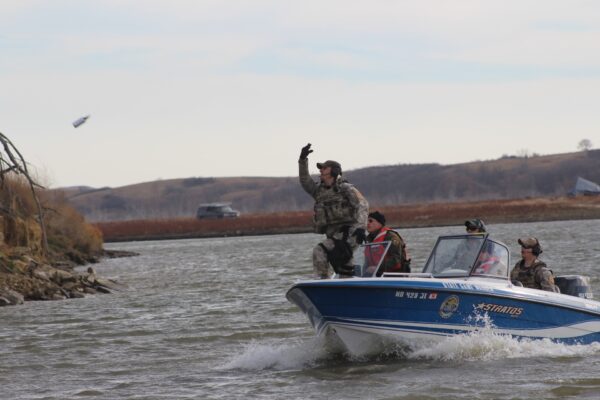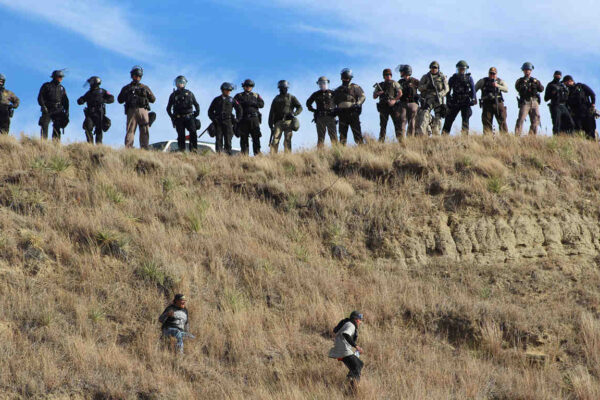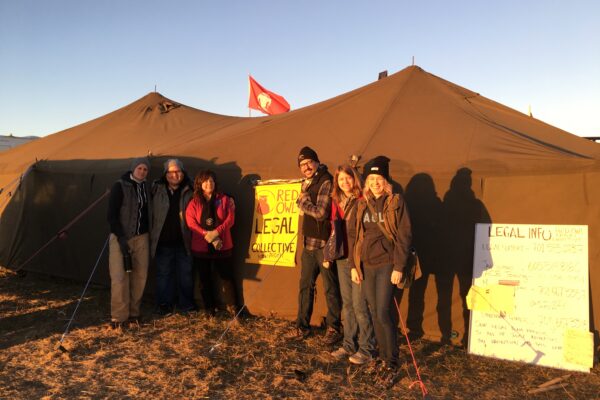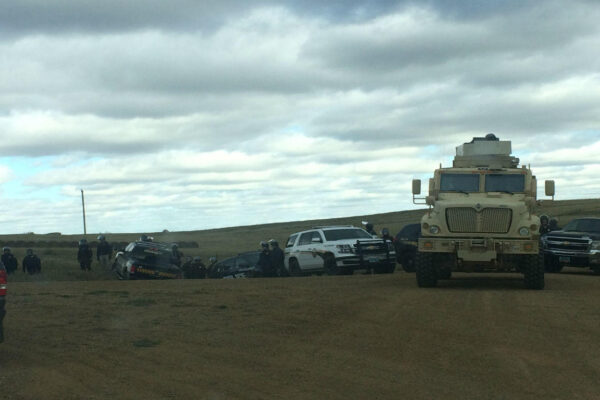Today, the Army Corps of Engineers approved the final easement for the Dakota Access Pipeline to cross the Missouri River north of the Standing Rock Sioux Tribe’s reservation. The ACLU of Wyoming, along with ACLU Nationwide and the ACLU of North Dakota, has been on the ground in North Dakota supporting Water Protectors and highlighting the militarization of Standing Rock. The ACLU of Wyoming has also been working to support local activists to #StandWithStandingRock. This piece highlights the work being done by two local professors, Dr. Caskey Russell, Associate Professor in English & American Indian Studies, and Dr. Julia Obert, Associate Professor of English at the University of Wyoming.
Drs. Russell and Obert led a group of University of Wyoming students to Standing Rock in November. This is their account.
Standing With Standing Rock
I want to know what you are doing on this road. - Sitting Bull to the U.S. Military, 1876[1]
In the early evening of November 20th 2016, on the Backwater Bridge just north of the Oceti Sakowin camp near the Standing Rock Reservation in North Dakota, heavily militarized police, National Guardsmen, and private security forces attacked indigenous water protectors and their allies. The attack started when water protectors tried to clear two burned-out trucks from the bridge—a public roadway—which was barricaded by police to bar access to the Dakota Access Pipeline drill site. The barricade also blocked travel, including by emergency responders from Bismarck, the nearest town with comprehensive medical facilities. 167 peaceful protesters were injured during the attack, many severely so. Both authors watched the night’s events unfold from the relative safety of a small rise southwest of the bridge approximately one hundred yards from the frontline. We witnessed unsparing brutality against peaceful protesters and have struggled, in the days following, to put that brutality into words. This essay is our attempt to describe what we observed that night, as well as to situate the events of November 20th within the long history of state-sponsored violence against indigenous people in the United States.
November 20th, 2016 was also the forty-seventh anniversary of the initial Occupation of Alcatraz, when 78 American Indians, calling themselves Indians of All Tribes, landed on the island and began a nearly two-year occupation to call attention to historical injustices toward indigenous people. The occupation ended when the Coast Guard cordoned off the island and armed federal agents arrested and forcibly removed the remaining native activists.[2] The importance of this historical link must be stressed. The violence committed against indigenous people and allies at Standing Rock on November 20th, while egregious, was only the latest deployment of excessive force against indigenous resistance in America. Indeed, the violations of U.S. civil rights, constitutional rights, and the rights set forth in multiple articles of the United Nations Declaration on the Rights of Indigenous People that occurred that night are best understood within the context of decades—centuries, even—of indigenous struggles against ongoing colonialism in this country, and of the state’s violent efforts to quell those struggles.
The militarized presence on Highway 1806 on November 20th allowed law enforcement to visibly recast a peaceful protest as a war zone, creating the necessary space for police to define water protectors as lawless, retrogressive, and violent and thereby justifying aggression against them. Defining American Indian activism as violent is a common rhetorical move, and most Americans, fluent in stereotypes of native violence, accept such rhetoric unquestioningly. Tellingly, Morton County Sheriff Kyle Kirchmeier described the events of November 20th as “an ongoing riot” wherein indigenous protesters were “aggressive towards officers.” This explanation defies all eyewitness accounts of the evening (including our own, and including a good deal of drone footage captured at the scene) and serves as a retroactive ‘justification’ for stripping water protectors of basic human rights and subjecting them to extreme violence. Our hope is that our story can help to combat the duplicitousness of Kirchmeier’s narrative.
November 20th
Around 5pm on the evening of November 20th, as we stood in the parking lot near the entrance to Oceti Sakowin, the camp came to life. People hurried on foot and in vehicles toward the barricaded Backwater Bridge. We joined the crowd and made our way north along Highway 1806, and we could see, even from a distance, a major commotion on the bridge. We walked up a small hill to the southwest of the frontline and joined a group of friends, reporters, and drone operators observing the events. A semi-tractor, which had just succeeded in pulling one of two burned-out trucks off the bridge, stood idling directly below us. Massive floodlights illuminated the bridge. A number of large armored vehicles were amassed on the other side of the barricade, along with at least a dozen police cars.
Over the course of the evening we witnessed sound cannons being used against protesters, we saw percussion grenades go off amidst the crowd, and we watched two grenades shot in the air explode above the group massed on the bridge. We saw police shoot numerous tear gas canisters at water protectors, and also saw canisters catch fire in the dry grass near the north end of the bridge—fires that protesters then stamped out. During the entire ordeal a plane with its lights off circled overhead, followed later by a darkened helicopter. The plane’s presence coincided with the disruption of cellphone signal on the hill: as people standing near us tried to upload photos and videos of events as they unfolded, their screens flashed and went black. Two drone operators stood near us, and on their screens we watched the violent police response in close-up, including the initial deployment of the water cannons.
At no time did we see the water protectors engage in any violence. The police barraged the group on the bridge for hours with tear gas, rubber bullets, stinger balls, percussion grenades, high-pressure water, and so on, and the water protectors stood their ground. Some frontline protesters had makeshift shields, but the constant, heartbreaking screams for medics—every minute, so it seemed—testified to the brutality the protectors faced. The water cannons were particularly cruel in the frigid temperatures (it plummeted close to 20F after dark) and in our estimation amounted to torture.[3] We were heavily dressed for winter and yet we shivered the entire night; we could not imagine being doused with water in such cold. Nevertheless, we watched the water cannons hose down water protectors over and over, and watched the protectors stand with their arms open chanting, “Water is Life.” In one stunning moment, we saw a water protector stand above the crowd with his arms spread, chanting, “Black snake killaz!” The crowd responded in full voice.
The coordination between the water protectors and the medics during the chaos was amazing to witness: an incessant convoy of vehicles sped between camp and barricade to bring supplies and to carry the injured back to camp. One of our own party took part in the frontline action; he was gassed, sprayed with water, and hit by rubber bullets in the chest and back. Once we reunited with him, we took him to the medical tents, which were located in the center of camp. As we waited for him to be examined, hypothermic and bleeding protectors arrived in droves, while several people in shock huddled around a fire. Medical personnel and volunteers began the herculean effort of tending to the masses of injured, and we all started to bring warm clothes from the donation tent for those who had been doused by water.
Our colleague who took part in the frontline action was one of the first people on the Backwater Bridge that evening. He told us that the action was inspired by an elder, who encouraged participants to clear the bridge to allow for quicker medical access to the camp from Bismarck. The water protectors first tried negotiating with the police behind the barricade, but the police refused to engage. According to our friend, one of the water protectors told the police, “We want to clear this bridge to help [with medical access between Bismarck and the reservation]…. We’re not trying to hurt anyone. We’re trying to get these trucks out of the way.” An officer with a loudspeaker told protesters to get back or risk being removed by force from the bridge. The police made that announcement several times and then fell silent.
As the water protectors were cutting the chains that attached to the trucks to the barricades, the police deployed mace against them. “Once the chains were gone,” our companion said, “that’s when they started with the tear gas … and they were shooting. Before we had the semi backed up, they were already shooting people down.” The police shot water protectors with rubber bullets in their heads, knees, and chests from a distance of fifteen feet. Our colleague noted that, “When someone would go down, instead of letting someone help them, they’d shoot whoever came up to help them.” The water protectors couldn’t remove the second truck due to the force being used against them: they faced a steady barrage of rubber bullets, tear gas, and percussion grenades.
Asked what he felt was the worst violence the water protectors faced that evening, our friend stated, “The worst to me was by far the concussion grenades…. The second time they got me [with a grenade] I thought it was a tear gas canister … and when that one blew up it dropped me straight to the ground … I couldn’t even get up. I just kinda was dazed, and sat there … all I could hear was ringing. I mean, I played football for years and years, took a lot of hard hits, but never had felt that [kind of force before].”
In describing the attitude of the police, our colleague said, “it was like they made it into a game. They were having fun out there. They were shooting people who [were just] praying or singing…. I saw three or four women get shot right in the face or in the head…. They would shoot people [while] laughing; I saw officers [who] were standing next to each other, one would be firing for a while and then give the gun to his buddy and it was his turn to do it.”
Our companion confirmed that no violence was directed towards police by protesters during his time on the frontlines. He told us, “There [were] a lot of people getting mad, getting angry, but as far as anything being back onto the cops, no. There [were] elders up there [on the front lines], and people up there yelling just to sing to them [the police], that was it. They didn’t have [anyone] up there telling them to get them or anything.” Our friend also noted that there was a vehicle on the bridge that accessed water protectors’ phones. The frontline videos he took that evening were mysteriously erased from his device.
The next morning, Monday November 21st, the water protectors held a vigil on the bridge. The situation was tense. The police intermittently exclaimed through their loudspeaker, “Move to the south of the bridge. You are illegally trespassing and will be arrested for criminal trespass, and munitions will be used to effect those arrests. Move to the south of the bridge to avoid this.” Water protectors had warming fire, hot drinks, and food on the bridge, which they offered to all who joined in the vigil. To the north side of the bridge, protectors walked around the grass with their hands in the air trying to engage the police in non-confrontational conversation. The group intermittently chanted “Please go home” in the direction of law enforcement personnel and then returned to their silence. At various times water protectors flashed the peace symbol toward the police officers and the snipers on the ridges surrounding the bridge. The protesters’ response to the police brutality of November 20th was peaceful and prayerful, in keeping with the previous evening’s disciplined, non-violent approach.
Before & Beyond November 20th
Sitting Bull’s inquiry of the US military comes to mind in reflecting upon the events of November 20th: We want to know what they were doing on that road. Regardless of the officially stated reason for the police presence on the Backwater Bridge, the officers were there to keep water protectors from accessing the pipeline drilling site and to allow Energy Transfer Partners to continue its work free from protest. The militarized police were on Highway 1806 to allow the company to break the law both in its access to and destruction of Sioux treaty territory, and in its continued construction of the pipeline without the necessary easement permits or tribal consultation.[4] The point cannot be understated: the militarized police, National Guard, and private security were on that road to allow a natural gas company to break federal law without interference from peaceful protesters—protesters who sought only clean drinking water and a common standard of law that applies as evenly to corporations as it does to people.
It is safe to assume that were the pipeline routed under the Missouri River, the health of at least some law enforcement officers and their families who live in nearby areas would be put at risk in the event of a pipeline rupture. These officers could have better served their country and their communities over the last few months by blocking DAPL at the drill site until proper review of treaty rights, easement issues, and permits had taken place. In other words, law enforcement should rightfully have been on the side of law-abiding citizens rather than that of corporate lawbreakers. Instead, officers vehemently enacted racialized violence to quiet the protests of those citizens. To repeat our earlier point, however, this response is far from surprising: Standing Rock is not a singular moment; it is yet another instance in which legal protections have failed to apply to indigenous people and in which state-sponsored brutality has been used to try and quiet responses to those failings. If white Americans—many of whom are probably just now hearing about Standing Rock for the first time, despite the fact that the protest there has been ongoing since April—are shocked by the events of November 20th, they shouldn’t be.
When we returned from Standing Rock, some of our acquaintances asked us if we thought the water protectors’ actions would be successful. What will happen, they asked, if the pipeline gets completed and the river drilled? Such questions betray an unawareness of indigenous history and its relation to ongoing struggles. While Standing Rock is unique in the number of indigenous nations that have pledged their support to the cause, and while the immediate purpose of the water protectors is to halt or reroute the pipeline’s construction, those facts are part of a larger, long-standing, and ongoing fight. If indeed the pipeline is stopped, it will not end the other struggles, environmental and anti-colonial, in which indigenous people in this country and across the world are currently engaged. The key will be to keep strengthening the Standing Rock coalition and to bring its force to bear on other indigenous resistance movements.
For indigenous people, there is no single endgame nor any one individual or group action that will put an end to settler colonialism and its destructive mentality. Rather, being indigenous requires constant struggling and rebuilding. In her novel Tracks, Anishinaabe author Louise Erdrich uses the metaphor of a rope unraveling at both ends to illustrate the disintegration and destruction of indigenous tribes at the hands of colonization. Reweaving that rope, reversing generations of destruction, cannot be effected by a single event, nor can it be achieved by adhering to the mentality that demands problems be resolved in such a fashion. Rather, the process of repairing indigenous communities is a struggle—a mode of resistance—that has been going on for many years and that adheres to the indigenous commitment to making sure one’s actions serve the health of one’s ancestors, both those who have come before and those who will come after. If that resistance is met with state violence, the resistance will nevertheless continue.
[1] The full statement, which was directed towards the US military on the road to Ft. Keough in present-day Montana and written in English by Johnny Brighiere (a native companion of Sitting Bull) at the behest of Sitting Bull, reads: “I want to know what you are doing on this road. You scare all the buffalo away. I want to hunt in this place. I want you to turn back from here. If you don’t, I will fight you again. I want you to leave what you have got here, and turn back from here. I am your friend. Sitting Bull.” Dee Brown, Bury My Heart at Wounded Knee, pg 289. For further context see Stanley Vestal’s Warparth: The True Story of the Fighting Sioux in a Biography of White Bull pg 222.
[2] For more information, see Smith and Warrior’s Like a Hurricane: The Indian Movement from Alcatraz to Wounded Knee.
[3] During a press interview, the Mandan police chief Jason Ziegler was queried about the use of water cannons in such frigid temperatures. He stated, “It was effective, wasn’t it? We can use whatever force is necessary to maintain peace. When they are throwing rocks, burning logs, shooting sling shots with projectiles at our officers, that would fall under what we would call less lethal, same things as rubber bullets, which doesn’t hurt as much.” Such an attitude is appalling. Especially worrisome is the statement that police can use whatever force necessary to maintain the peace, which would justify torture and lethal weapons and which also raises questions of who determines what peace is. See http://aptn.ca/news/2016/11/22/did-north-dakota-police-use-water-as-a-weaspon-against-nodapl-supporters-depends-on-which-police-force-you-ask/. November 22, 2016. Jorge Barrera.
[4] For a good overview of the legal issues and documents surrounding DAPL, see http://earthjustice.org/features/faq-standing-rock-litigation#.
To view the Standing Rock Sioux’s complaint against the US Army Corps of Engineers, see
http://earthjustice.org/sites/default/files/files/3154%201%20Complaint.pdf




